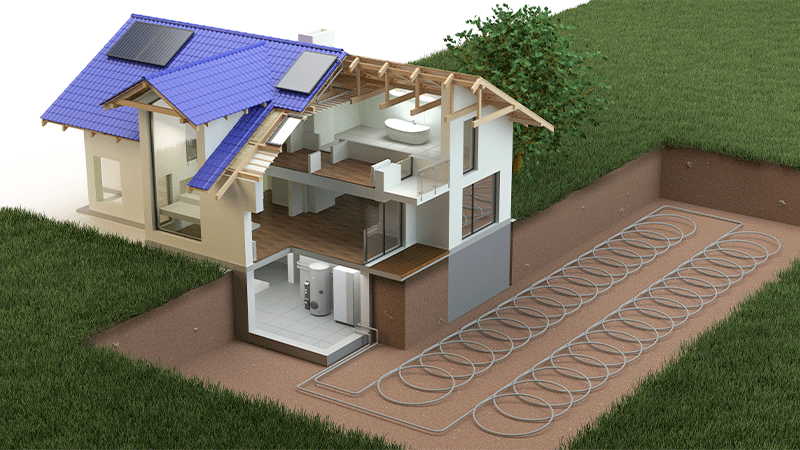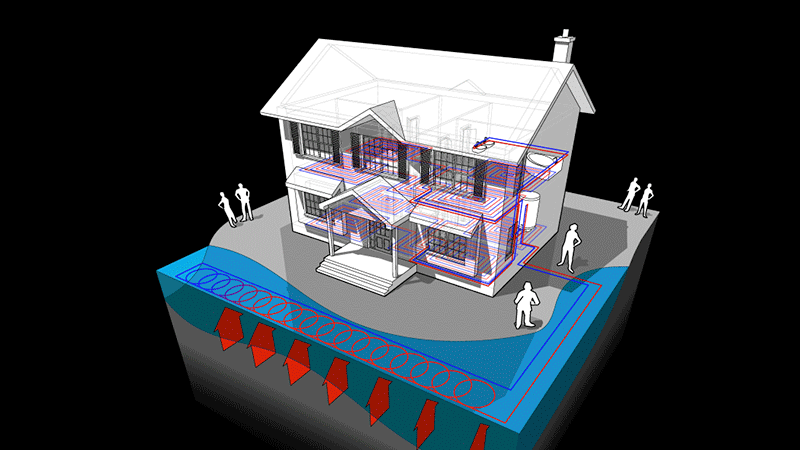Geothermal Heated Driveway Toronto
HeatWay helps you get free energy from the earth. With our geothermal heat pumps, you can enjoy snow-free driveways
What is a Geothermal Heated Driveway?
Geothermal heated driveway systems are among the most energy-efficient heated driveway technologies. We use a geothermal heat pump in our heated driveway system.
A geothermal heat pump extracts heat from the ground or the soil rather than the air. This is a heat source that is significantly more reliable.
While the outside air temperature changes with the seasons, geothermal heat remains constant. Because of this, geothermal heat pumps are much more efficient than other types of heat pump systems.
The system is excellent for melting snow and underfloor heating. Your sanitary water can be heated simultaneously by this system. A geothermal heat pump also enables passive summer cooling, reducing electricity consumption

How does a Geothermal Heated Driveway work?
We know the earth is full of energy. The temperature is different on the surface of the earth and in the deeper layers of the earth. Heat reservoirs cause this phenomenon.
A geothermal heat pump, also known as a groundwater heat pump, extracts that energy. This is done using a pipe system in the soil (via a vertical or horizontal brine network). The liquid in these pipes absorbs the natural geothermal heat.
A heated Driveway system uses this heat to heat your driveways, sidewalks, or home.
What types of Geothermal Heat Pumps are used in Heated Driveways?
Three main types of geothermal heating systems are used in heated driveway systems. We will recommend the one that best fits your needs and the environment of your home.
Vertical capture net
We drill holes in the garden for a geothermal heat pump with vertical capture. The number and depth depend on the required heating capacity, the local subsurface, and the location. After drilling between 50 and 150m depth, we will place one or more closed circuits in the ground. The circuit’s substance absorbs the earth’s heat and transfers it to the heat pump.
Advantages
- very high efficiency
- short payback period
- little surface area required
- possibility of passive cooling
- lowers the energy consumption
- needs little maintenance
- very long service life (more than 70 years)
Disadvantages
- More considerable investment than a horizontal capture

Horizontal capture brine network
We will bury numerous closed circuits (pipes) in your garden. We will place the closed circuit 20 cm below the frost line. For Canada, this is usually at a depth of 0.8 to 1.5m. Water with antifreeze flows into it.
The heat pump extracts geothermal heat from the soil. Rainfall, solar radiation, and other atmospheric factors can be heat sources. The critical area is calculated based on the type of surface.
Advantages
- high efficiency
- Best price/performance ratio
- short payback period
- lower investment
- possibility of passive cooling
- lowers electricity consumption
- needs little maintenance
- very long service life (about 70 years)
Disadvantages
- needs more space in the garden
- subsidence is possible
- buildings and robust vegetation reduce the efficiency of Horizontal capture

Groundwater/surface water
We can also use groundwater as a heat source. We must drill at least two wells to pump and bring the water back into the soil layer.
Sufficient groundwater must be easily accessible. Otherwise, this system cannot be used (for a 50 kW heat pump, approximately 10-12 m³ of water /h is required).
Advantages
- very high efficiency
- short payback period
- little surface area is required
- possibility of passive cooling
- lowers energy consumption
- easily scalable
Disadvantages
- big investment
- An official permit is required for drilling and water consumption
- Needs more maintenance

Geothermal Heated Driveway at HeatedWay company
We provide geothermal heat pumps for heating, cooling, and, most importantly, snow melting. The geothermal heat pump will supply the heated hydronic or electric-heated driveway.
Compared to a gas or oil heating installation, the initial cost of a Geothermal Heated Driveway is higher. But the payback period is between 8 and 10 years.
We operate a Geothermal Heated Driveway that saves a lot of money for you. Using geothermal energy to heat your building will save 500,000 liters of oil and 700,000 cubic meters of gas over 25 years.
So if you decide to achieve two goals with one action, you must contact us.
FAQ
With vertical geothermal energy with soil drilling, the surface area does not matter. For a horizontal capture, an area of approximately 250 m² is required (for heating an average home and snow melting the outside surfaces such as driveways)
The depth depends on the required heating capacity, the local subsurface, and the location in the garden. We calculate this in advance.
Geothermal heat pumps are suitable for all new construction and renovation heating installations. Systems such as geothermal underfloor heating and geothermal snow melting have the highest efficiency.

